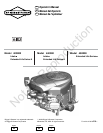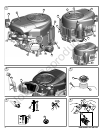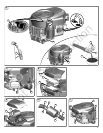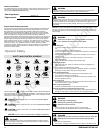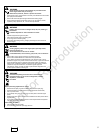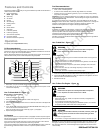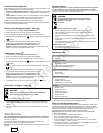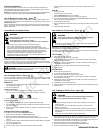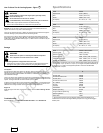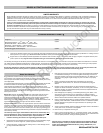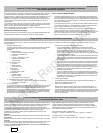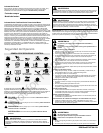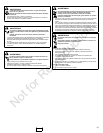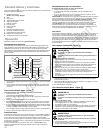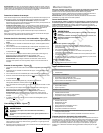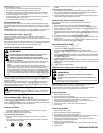
7
en
Determine The Starting System
Before starting the engine, youmust determine the type of startingsystem that is on your
engine. Your engine will have one of the following types.
• Electronic Fuel Management System: This features an Electronic Control Unit that
monitors engine and temperature conditions. It does not have a manual choke or a
primer.
• Choke System: This features a choke to be used for starting in cool temperatures.
Some models will have a separate choke control while others will have a
combination choke /throttle control. This type does not have a primer.
To start your engine, follow the instructions for your type of starting system.
Note: Some engines and equipment have remote controls. See the equipment manual
for location and operation of remote controls.
Electronic Fuel Management System - Figure
4
1. Check the oil level. See the How To Check/Add Oil section.
2. Make sure equipment drive controls, if equipped, are disengaged.
3. Turn the fuel shut -off valve (A), if equipped, to the on position (Figure 4).
4. Move the throttle control (B)tothefast
position. Operate the engine in the fast
position.
5. Turn the electric start switch (D) to the on/start position (Figure 4).
NOTE: If the engine does not start after repeated attempts, go to
BRIGGSandSTRATTON.COM or call 1-800-233-3723 (in USA).
NOTICE: To extend the life of the starter, use short starting cycles (five seconds
maximum). Wait one minute between starting cycles.
Choke System - Figure
4
1. Check the oil level. See the How To Check/Add Oil section.
2. Make sure equipment drive controls, if equipped, are disengaged.
3. Turn the fuel shut -off valve (A), if equipped, to the on position (Figure 4).
4. Move the throttle control (B)tothefast
position. Operate the engine in the fast
position.
5. Move the choke control (C), or the combination choke/throttle lever, to the choke
position.
Note: Choke is usually unnecessary when restarting a warm engine.
6. Turn the electric start switch (D) to t he on/start position (Figure 4).
NOTE: If the engine does not start after repeated attempts, go to
BRIGGSandSTRATTON.COM or call 1-800-233-3723 (in USA).
NOTICE: To extend the life of the starter, use short starting cycles (five seconds
maximum). Wait one minute between starting cycles.
7. As the engine warms up, move the choke control (C)totherun
position.
How To Stop The Engine - Figure
4
WARNING
Gasoline and its vapors are extremely flammable and explosive.
Fire or explosion can cause severe burns or death.
• Do not choke the carburetor to stop engine.
1. Move the throttle control to the slow position. Turn the key switch (D) to the off
position (Figure 4). Remove the key and keep in a safe place out of the reach of
children.
2. After the engine stops, turn the fuel shut-off valve (A), if equipped, to the closed
position.
Maintenance
Use only original equipment replacement parts. Other parts may not perform as
well, may damage the unit, and may result in injury. In addition, use of other parts
may void your warranty.
We recommend that you see any Briggs & Stratton Authorized Dealer for all
maintenance and service of the engine and engine parts.
NOTICE: All the components used to build this engine must remain in place for proper
operation.
Emissions Control
Maintenance, replacement, or repair of the emissions control devices and systems
may be performed by any non-road engine repair establishment or individual.
However, to obtain “no charge” emissions control service, the work must be performed
by a factory authorized dealer. See the Emissions Warranty.
Unintentional sparking can result in fire or electric shock.
Unintentional start-up can result in entanglement, traumatic
amputation, or laceration.
Fire hazard
WARNING
Before performing adjustments or repairs:
• Disconnect the spark plug wire and keep it away from the spark plug.
• Disconnect battery at negative terminal (only engines with electric start.)
• Use only correct tools.
• Do not tamper with governor spring, links or other parts to increase engine
speed.
• Replacement parts must be the same and installed in the same position as the
original parts.
• Do not strike the flywheel with a hammer or hard object because the flywheel
may later shatter during operation.
When testing for spark:
• Use approved spark plug tester.
• Do not check for spark with spark plug removed.
Maintenance Chart
First 5 Hours
• Change oil
Every8HoursorDaily
• Check engine oil level
• Clean area around muffler and controls
• Clean finger guard/rotating screen
Every 25 Hours or Annually
• Clean air filter *
• Clean pre-cleaner *
Every 50 Hours or Annually
• Change engine oil
• Replace oil filter (if equipped)
• Check muffler and spark arrester
Annually
• Replace air filter
• Replace pre-cleaner
• Replace spark plugs
• Clean air cooling system *
• Replace fuel filter
• Check valve clearance **
* In dusty conditions or when airborne debris is present, clean more often.
** Not required unless engine performance problems are noted.
Electronic Fuel Management System
The Electronic Fuel Management System monitors engine temperature, engine speed,
and the battery voltage. The system uses this data to adjust the choke to provide the
proper air and fuel mixture during engine starting and warm up. There are no settings or
adjustments on the system. If starting or operation problems occur, contact an
Authorized Briggs & Stratton Dealer to have the problem corrected.
NOTICE: Make sure to follow the steps below or the Electronic Fuel Management
System could be damaged.
• Never start the engine if the battery cables are loose.
• Never use a battery charger to start the engine.
• Never disconnect the battery cables while the engine is running.
• When connecting the battery cables, first connect the positive (+) cable and then
connect the negative (--) cable to the battery.
• When charging the battery, turn the ignition switch to the off position and disconnect
the negative (--) battery cable from the battery.
• Do not spray water directly on the Electronic Control Unit.
Not for Reproduction



